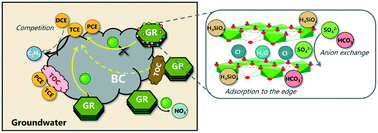Chlorinated solvent degradation in groundwater by green rust–bone char composite: solute interactions and chlorinated ethylene competition†
Abstract
Biochar works as a green catalyst for the dechlorination of chlorinated ethylenes (CEs) by green rust (GR). Although the GR–biochar composite shows great potential for groundwater remediation, its performance under simulated field conditions has not been investigated. In this study, a composite of chloride GR and bone char (BC) was used to investigate the effect of groundwater solutes (Cl−, SO42−, HCO3−, and H4SiO4) and the co-existence of one or two CE(s) on GR–BC reactivity with CEs. Furthermore, a contaminant-free groundwater and five CE-contaminated groundwaters were collected to test the reactivity of the GR–BC composite under real groundwater conditions. Among all tested groundwater solutes, HCO3− affected CE dechlorination rates the most, exemplified by a 6.7-fold decrease in trichloroethylene (TCE) reduction rate constant, kmass, to 0.16 L g−1 h−1 in the presence of 10 mM HCO3− solution when compared to the solute free experiment. Silicic acid led to a 1.7-fold decrease in kmass at concentrations of 0.5 and 1 mM and a 5.3-fold decrease at 2 mM. TCE reduction rate was also decreased by the co-existence of PCE (by a factor of 1.6), while cDCE had very little impact. Natural groundwater matrices led to up to 52-fold decrease in kmass(TCE), depending on the complexity and pollutant profile of the groundwater. However, relatively fast dechlorination with kmass(TCE) ≥ 0.021 L g−1 h−1 was seen in all tested CE-contaminated groundwaters where CE concentrations were comparable. For hard groundwaters, HCO3− is recognized as the main inhibitor for dechlorination, while the impact of the other tested solutes is minor. The study provides practical information for the application of the GR–BC composite for remediation of CE-contaminated groundwaters.

- This article is part of the themed collection: Environmental Science: Water Research & Technology Recent HOT Articles


 Please wait while we load your content...
Please wait while we load your content...